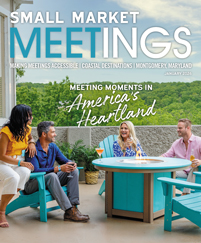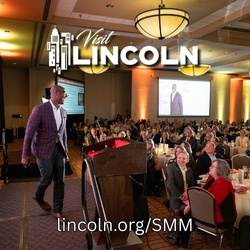The Land of Lincoln has a rich history that dates back to the early 1800s. Meeting planners can incorporate some of that history by hosting events at these five state historic sites.
Edwards Place Historic Home
Springfield
Built in 1833 and remodeled in 1857, Edwards Place is a historic home that tells the story of social and domestic life in Springfield during Abraham Lincoln’s time. The Italianate mansion was built by Benjamin Edwards, an attorney who met Lincoln more than 400 times in court. Edwards was the youngest son of Illinois governor Ninian Edwards. His other Lincoln connection is that his brother married Mary Todd Lincoln’s sister Elizabeth.
The historic home was fully restored starting in 2014. All of its rooms are now furnished in a historically accurate style.
The first floor of the home features four parlors on one side and a dining room and small salon on the other. The facility can seat up to 50 guests for a banquet or about 100 for a cocktail reception. The home is managed by the Springfield Art Association. There is an art gallery space connected to the house, which can accommodate 60 guests for a banquet. If they need more space, groups can also rent out the house and gallery.
Groups that rent out space will often add docent-led tours to their bookings. One of the highlights of the home tour is the courting couch where Abraham Lincoln met and began his courtship with Mary Todd, as well as a piano that was played at their wedding.
Governor Duncan Mansion Historic Site
Jacksonville
Construction on the Governor Duncan Mansion in Jacksonville began in 1833 and was completed in 1834. It was built by Joseph Duncan, the fifth governor of Illinois from 1834 to 1838, and his wife, Elizabeth. The house, which served as the official executive mansion and the family home during his tenure, is three stories and has 17 rooms.
The home is special in that it has two front doors, one that leads into the residence and one that leads directly into the governor’s office on the first floor. It is decorated in the 1890s style and features a combination of electric and gas jet chandeliers. The site features many items that belonged to the Duncan family.
The family sold the home to the local chapter of the Daughters of the American Revolution for $11,000. To pay for the building, the DAR sold marble tablets to local families for $100 each. The tablets, which hang on a wall in the mansion, were inscribed with the name of their family’s first member to live in Morgan County.
There is a large parlor on the first floor that can host 40 people at card tables or 60 to 75 people for standing receptions. The downstairs has a large central hallway, and many groups will rent out the entire first floor, catering food out of the dining room and using the parlor for the rest of their event. Groups can also rent out the garden. Tours of the mansion are available.
I&M Canal Visitor Center
LaSalle
The 96-mile-long Illinois and Michigan Canal opened in 1848 as a way to connect the Great Lakes to the Illinois and Mississippi rivers. Along with the Erie Canal, it created a gateway from the Great Lakes all the way to New Orleans. When the canal opened, Chicago was the frontier.
Groups wanting to learn more about the canal and experience it for themselves can meet at the I&M Canal Visitor Center in Lasalle. The group’s main emphasis is to teach the history of the canal. One of the ways they do so is aboard a 76-foot replica canal boat built in 2008 by a nonprofit organization. The boat is pulled the old-fashioned way by a mule named Moe. The boat can hold 70 people and gives rides to tourists four days a week.
The crew, decked out in 1840s garb, tell passengers about how the canal was built, what it was like to work on the canal and how the area grew up around the waterway. If a group is larger than 70, it can still rent out the boat, but the boat can’t leave the dock. Some groups will organize a buffet lunch in the Vintage Room at the visitor center before hopping on the canal boat for a tour. The vintage room can hold 45 people.
The boat can’t host large meals, but groups can serve drinks and hors d’oeuvres onboard. The canal isn’t deep — only a few feet of water. Moe walks between two and four miles per hour. There is no engine onboard, so the ride is very smooth and the surroundings scenic. Guests will see herons, egrets, fish and snakes in the water, as well as deer and turtles sunning themselves on the rocks.
The Genesee Theatre
Waukegan
Originally built as a movie palace in 1927, the Genesee Theatre in Waukegan is the last of its kind standing in the city. The facility includes the auditorium where shows were performed and the surrounding building, which was an apartment complex with a storefront on the first floor. The fifth-floor apartments were used to house the crews and actors who came in for the productions. That lasted until the 1970s, when people lost interest in the theater, and it fell into disrepair.
The city of Waukegan took over the property in the 1990s, and in 2003 an effort was made to reopen the theater and revitalize it. As part of the revitalization, the theater and apartment complex were combined into one facility, with the former apartments turned into seven separate lounge spaces. The grand opening was held in 2004. In 2013, the facility became a nonprofit.
Groups of all sizes can rent out space at the theater, from a 15-person luncheon to a full sellout of the building with 2,000-plus people. Corporate groups like to do presentations on the main stage for 100 to 200 people.
Each of the seven lounges can host groups of 50 to 75 people, depending on the layout.
The theater itself has all of the latest sound, lighting and projection systems. Groups renting the lounges will need to bring in their own A/V equipment. The theater has two lobbies, both of which can be used for events.
John C. Flanagan House Museum
Peoria
Built in 1837 by John Flanagan, an early settler of the area, the John C. Flanagan House Museum is the oldest standing house in Peoria. It is situated on Peoria’s east bluff with an expansive backyard view of the Illinois River Valley.
The facility is owned and operated by the Peoria Historical Society and is decorated with furnishings from the mid-19th century to the early 20th century.
The main parlor, dining room and library spaces are available for small meetings and gatherings. A long porch at the back of the house can also be used for events. The backyard offers a unique outdoor setting with a river view and all-season flower beds.
The parlor can host 40 guests seated, while an open house reception can accommodate up to 60. The dining room and library can each host small events for 10 guests each. Groups that rent the home will need to bring in their own chairs and A/V equipment. There is a small kitchen available for food prep, but meeting groups are encouraged to bring in food from local caterers.
Groups interested in the history of the home can add docent-guided house tours for an additional fee.












